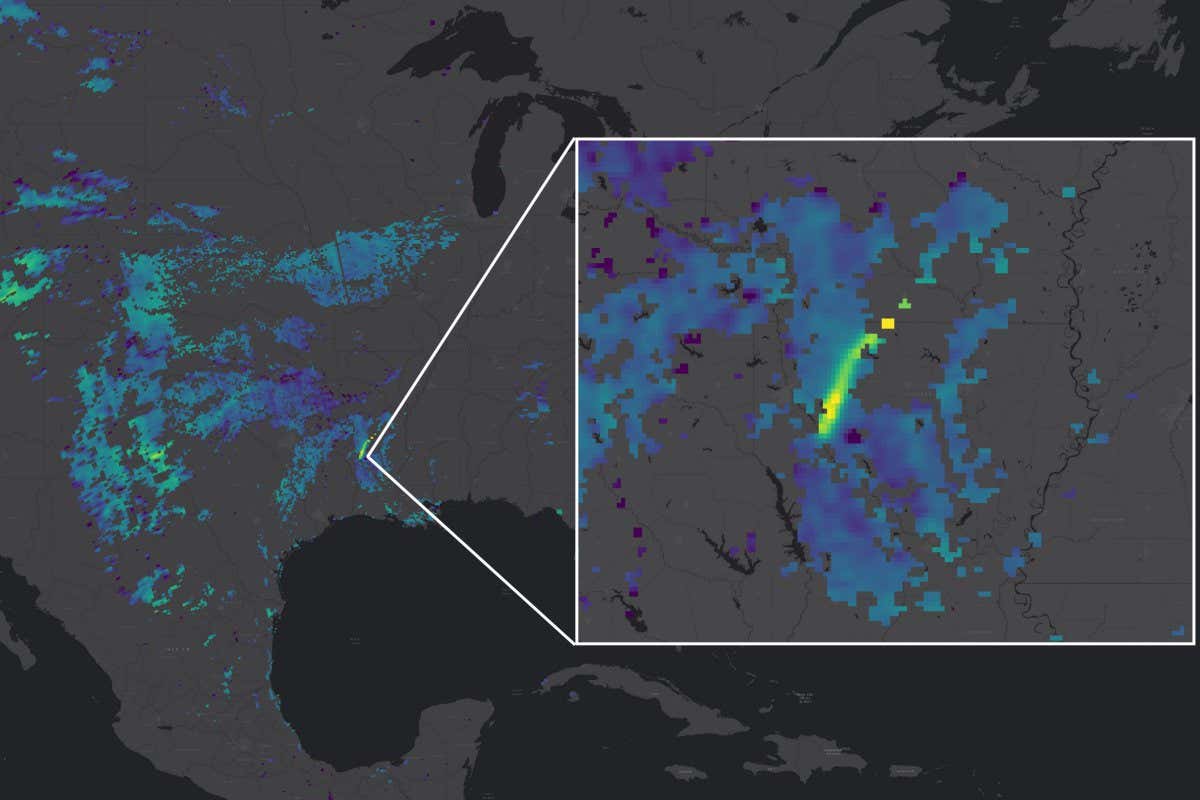Images captured by satellite have been run through an algorithm to automatically detect the biggest plumes of methane streaming from oil and gas facilities worldwide
Environment 3 February 2022
By Adam Vaughan
Example of a methane plume detected over the United States in satellite images from 2019
Kayrros, Inc.; Esri, HERE, Garmin, FAO, NOAA, USGS, © OpenStreetMap contributors, and the GIS User Community
About a tenth of the global oil and gas industry’s methane emissions have been found to come from a group of “ultra-emitter” sites located mostly in Turkmenistan, Russia and the US. Methane is a powerful greenhouse gas that governments recently agreed to slash by 2030.
While huge plumes of methane leaking from gas pipelines have been detected by satellites at individual sites, such as a gas well in Ohio and several pipelines in central Turkmenistan, little has been know about their extent globally.
Now, images captured by an instrument aboard a satellite have been run through an algorithm to automatically detect the biggest plumes of methane streaming from oil and gas facilities worldwide.
Advertisement
These ultra-emitters were spotted pumping out more than 25 tonnes of methane an hour. That’s “a heck of a lot”, says Steve Hamburg at Environmental Defense Fund (EDF), a US non-profit organisation. Collectively, these contribute about 8 million tonnes of methane a year, about a tenth of the oil and gas industry’s total annual emissions for 2019-20.
Turkmenistan was the biggest ultra-emitter, releasing more than a million tonnes of methane between 2019 and 2020. Russia was second at just under a million tonnes, followed by the US, Iran, Algeria and Kazakhstan.
The US count is probably low because it excluded a major oil and gas region, the Permian basin, due to monitoring difficulties. By contrast to these countries, other major oil producing countries, including Kuwait and Saudi Arabia, had very few ultra-emitters.
Drew Shindell at Duke University in North Carolina, part of the team behind the analysis, says the big differences between countries gives hope that bad practice – where gas is released to the atmosphere for pipe repairs rather than pumped to another section of pipe – can be improved. “It shows if we put some effort in, we can have hardly any leaks or intentional releases that are large enough to be seen from space,” he says.
The study also found that ultra-emitting sites are releasing so much methane, which could be sold, that it should be cost effective to solve. For the six worst countries, tackling those plumes should cost up to $300 less per tonne than it would typically cost to reduce methane from oil and gas facilities in those nations. “Getting rid of these would be very inexpensive,” says Shindell.
Christophe McGlade at the International Energy Agency says the research: “Demonstrates the increasing viability of satellites to improve our understanding of methane emissions and highlights the importance of super-emitting events.”
The satellite isn’t everywhere all the time, so the findings are based on a snapshot and some ultra-emitters may have gone undetected. Hamburg says that while the global scope of the research is new and welcome, it is worth remembering that ultra-emitters are only a small slice of oil and gas’s methane problem. Stephane Germain at Canadian firm GHGSat says the study paints a “very important picture of ultra-emitters” but the satellite that its data came from offers a resolution too coarse to track plumes back to individual facilities.
A new EDF satellite due to launch next year will scrutinise much smaller but more numerous plumes that make up the bulk of the industry’s emissions.
Journal reference: Science, DOI: 10.1126/science.abj4351
Join us for a mind-blowing festival of ideas and experiences. New Scientist Live is going hybrid, with a live in-person event in Manchester, UK, that you can also enjoy from the comfort of your own home, from 12 to 14 March 2022. Find out more.
More on these topics:
































